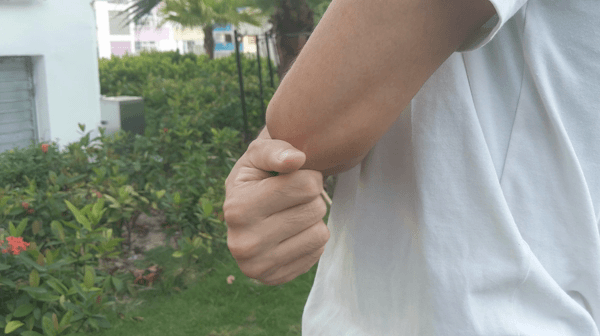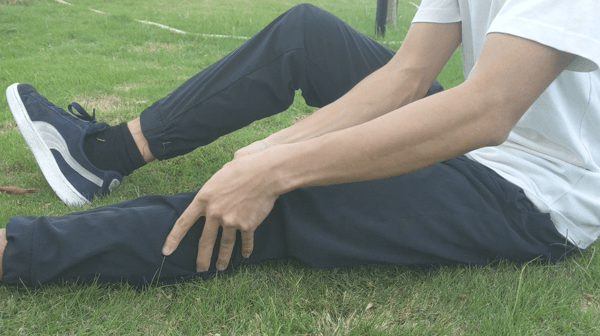Light as a feather but strong as steel inside.
This is a good metaphor to describe the people who stretch regularly.
For stretching, our goal is to aim for the lightness that we can feel in every part of our body and be stretchy.

But what does lightness mean?
It means we don’t generally feel the blockage or heaviness in any part of the body, and that we can easily do poses at any time, anywhere. A blockage is a flow of Qi being interrupted. When we feel somewhere is blocked, we feel the discomfort from the part of the body and it usually makes us moody.
Meanwhile, the heaviness generally comes from the overused muscles whether it’s by a prolonged issue or a new activity has been taken. Imagine a runner finishes his serious training session, his legs are now tired and sore. But the weary muscles aren’t limited to only the leg parts, so the next day he wakes up, he starts to feel the weight all over him and he might think of his body like a sail for a second. These kinds of situations are far from unheard of. They happen to ordinary people too.
*Notice that heaviness does not mean the weight of a person, but rather the cause from the muscles used and inflexibility that without proper relief.
When light exercises, like walking, or even holding the phone, happen repeatedly without alleviation, blockage, hidden pain, or heaviness will take forms and grow on us. But sometimes, problems develop too slowly we don’t realise, like the fable of the boiling frog.
So the feeling of lightness, if one can feel its state, can be a measurement for ourselves to determine our overall health, including mobility, flexibility, durability, and so on.
Though keep in mind that:
Feeling light does not equal to weak.
Feeling light should have a sense of strong inner power within, and that is the strength.
Feeling light is the whole body state, while the parts of the body should be smooth and painless.
Feeling light is ongoing, not being hold up by the daily tasks.
Feeling light means we’re always ready; be on the move if needed.
Feeling light takes efforts and times.
Stretching is a quick and resilient method to alleviate our stressed body and enhance the lightness over time.
Besides the physical improvement, Stretching also helps improve thinking. The more one stretches, the time of one will become slower to the personal perspective in his/her world. This directly reflects the inner world, so certain concepts will then be developed. The tolerance, the understanding of life, the joys of living, will merge when one starts to stretch.
Before we talk more about stretching, one thing to note is that stretching and Yoga are two different practices but they overlap.
For me, as I’ve mentioned in previous stretching articles, I incorporate Yoga techniques that I learnt from my Yogist friend into my usual stretching routine, as a dancer. Therefore, I’m referring stretching method but really, it has many other outside elements being added in, like Yin-yang and so on. Hope that makes sense!
One concept for where to begin with stretching is to think of Balance. Stretching is easy because whatever the habitual postures we have been doing, we stretch them with the opposite directions.

*As you can see here, if I spend a lot of time sitting, my back, core and areas around are going to be stiff and irregulate over time. So, I’ll practice “the wheel” to balance it out and ease the unwanted pain in it.

The more repetitive movement is being performed, the easier for one to master it.
Applying “the balance concept” to our body, we can correct and fix the “abused” area and relieve the pains from not being stretched enough.
Think of an imaginary axis and a curve around us as we stand, however the median line leaning front or back, left or right, up or down, we focus on the opposite direction to stretch, this way we can truly develop our personal stretching routine and balance the used parts, whilst improving elasticity and flexibility on our joints, muscles and anything in-between within our body.
See? How simple Stretching actually is, and fun.
As we now get the direction going, let’s talk about the power that makes the journey happens.
Many of us, who did not attend Yoga classes or have not been taught about stretching, might not know the key to improve the flexibility is to use power to stretch. While it’s not wrong to be relaxed to stretch, to further improve the range of flexibility of a muscular area, we need to give power to its area to stretch in a relaxed state.
It might sound confusing. A simpler way to put this is to flex the stretching muscles while doing it. When you flex the muscles, there will be a power given and that helps against the stretching action, acting as a sustainable balance for better improvement. Think of a rubber band being stretched, it always needs both sides that are being held to make the stretch happens.
Okay, so when to implement?
-Whenever you feel stiff, or anytime really. It’s recommended to stretch when the energy isn’t too low, as we don’t want counterproductive efforts.
For how long?
- Seconds to minutes or hour.
Tip(s) for during it:
- Be naked is the fastest way to improve your stretching, as you eliminate the limitation of clothing.
- If you don’t know what to aim for as a starter, aim for the flexible back( Upper, Middle, and Lower), and flexible hips and pelvis. *A flexible back a SUPER important!
^ Simultaneously, stretch the calves and shoulders. - As you stretch more, you’ll encounter a period where more problems are coming out, which are good, because they’re the telling from the body that many areas are needed your attention.
^Don’t rush on doing them though, keep them in mind and do them one by one. Our body needs adjusting time for natural changes. - Enjoy and happy stretching :)
The goal:
For the beginners: Set comfortable, realistic goals for yourself to approach learning moves.
For the advanced: Find some gymnastic moves to do. They have awesome consecutive movements that can push your limits.
All in all, be super light and super flexible. It’s for yourself, not for anyone else. You keep doing it because you love health and flexibility.
*”Stretching helps improve thinking concept” comes from my best friend, Reflex, who is a visual artist, tagger(graffiti artist), and breakdancer. He is the perfect example of “weight and height do not define a person”, and that many of his dance movements come from very good flexibility, you can check it out more via his Instagram here.
Photo by Javardh from Unsplash
















